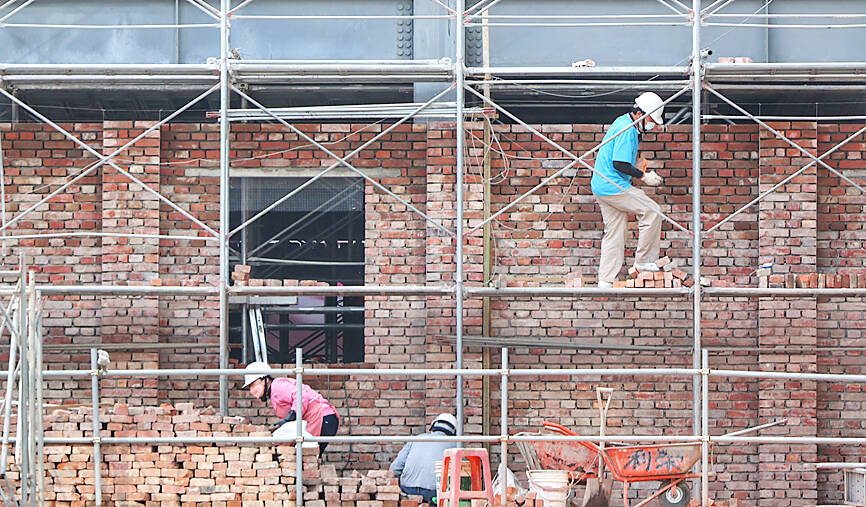Developers in northern Taiwan plan to roll out a record NT$418.24 billion (US$13.65 billion) of new projects for the spring sales season, almost double the volume last year, driven by residential, commercial and industrial properties, the Chinese-language My Housing Monthly (住展雜誌) said yesterday.
Residential projects would generate NT$222.9 billion from sales, or 53.29 percent, while commercial and industrial properties would make up for the remaining sum, the publication’s survey found.
The new high volume is due to the entry of index properties such as the Core Pacific Plaza (京華廣場), a mixed-use property in Taipei’s Songshan District (松山) by Dingyue Development Corp (鼎越開發), an affiliate of China Petrochemical Development Corp (中石化), it said.

Photo: CNA
The plaza would feature four upscale office buildings with 19 aboveground floors and seven basement floors on a 5,000 ping (16,529m2) plot of land on the former site of Living Mall (京華城).
The massive complex achieved Global Real Estate Sustainability Benchmark’s highest recognition for its environmentally friendly design, Dingyue said yesterday.
Taipei posted NT$260.37 billion in property projects from March 29 to the end of next month, it said, adding that projects valued at more than NT$25 billion would be seen in Daan (大安) and Zhongshan (中山) districts.
New Taipei City posted NT$80.63 billion in new projects, with Sanchong District (三重) contributing NT$35 billion, it said.
If plans proceed smoothly, the district could see 40 projects competing for buyers’ attention, making it the city’s most competitive area, it said.
Apartment units priced up to NT$18 million appear in Sanchong, it said.
In Taoyuan, overall sales would amount to NT$44.47 billion, and rezoning areas in Cingpu (青埔) and Gueishan (龜山) districts continue to be the main battleground, it said.
However, there is only one project by Farglory Land Development Co (遠雄建設) that would generate sales of more than NT$10 billion, as most other projects are relatively small, it said.
Hsinchu City and Hsinchu County would see sales of NT$31.17 billion in new projects as developers regain confidence after COVID-19 infections stabilize, it said.
New projects in Hsinchu County are planned in Sinpu (新埔), Hukou (湖口) and Sinfeng (新豐) townships as well as Jhubei City (竹北), it said.
Most developers prefer to stay on the sidelines until the government explains how it would ban transfers of presale house purchase agreements, the publication said, adding that the practice suggests the sales volume for the summer sales season would be huge.

The US dollar was trading at NT$29.7 at 10am today on the Taipei Foreign Exchange, as the New Taiwan dollar gained NT$1.364 from the previous close last week. The NT dollar continued to rise today, after surging 3.07 percent on Friday. After opening at NT$30.91, the NT dollar gained more than NT$1 in just 15 minutes, briefly passing the NT$30 mark. Before the US Department of the Treasury's semi-annual currency report came out, expectations that the NT dollar would keep rising were already building. The NT dollar on Friday closed at NT$31.064, up by NT$0.953 — a 3.07 percent single-day gain. Today,

‘SHORT TERM’: The local currency would likely remain strong in the near term, driven by anticipated US trade pressure, capital inflows and expectations of a US Fed rate cut The US dollar is expected to fall below NT$30 in the near term, as traders anticipate increased pressure from Washington for Taiwan to allow the New Taiwan dollar to appreciate, Cathay United Bank (國泰世華銀行) chief economist Lin Chi-chao (林啟超) said. Following a sharp drop in the greenback against the NT dollar on Friday, Lin told the Central News Agency that the local currency is likely to remain strong in the short term, driven in part by market psychology surrounding anticipated US policy pressure. On Friday, the US dollar fell NT$0.953, or 3.07 percent, closing at NT$31.064 — its lowest level since Jan.

The New Taiwan dollar and Taiwanese stocks surged on signs that trade tensions between the world’s top two economies might start easing and as US tech earnings boosted the outlook of the nation’s semiconductor exports. The NT dollar strengthened as much as 3.8 percent versus the US dollar to 30.815, the biggest intraday gain since January 2011, closing at NT$31.064. The benchmark TAIEX jumped 2.73 percent to outperform the region’s equity gauges. Outlook for global trade improved after China said it is assessing possible trade talks with the US, providing a boost for the nation’s currency and shares. As the NT dollar

The Financial Supervisory Commission (FSC) yesterday met with some of the nation’s largest insurance companies as a skyrocketing New Taiwan dollar piles pressure on their hundreds of billions of dollars in US bond investments. The commission has asked some life insurance firms, among the biggest Asian holders of US debt, to discuss how the rapidly strengthening NT dollar has impacted their operations, people familiar with the matter said. The meeting took place as the NT dollar jumped as much as 5 percent yesterday, its biggest intraday gain in more than three decades. The local currency surged as exporters rushed to